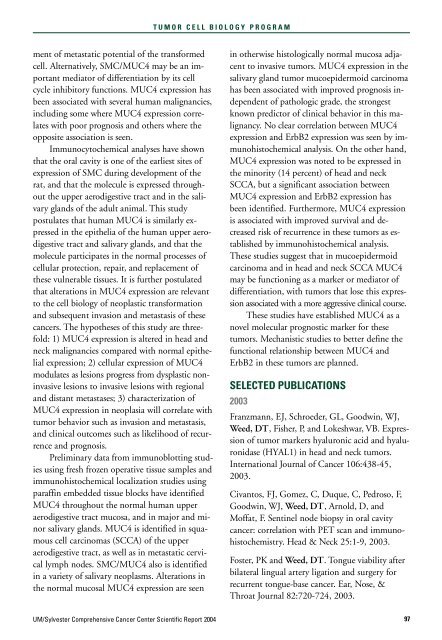SCIENTIFIC REPORT 2004 - Sylvester Comprehensive Cancer Center
SCIENTIFIC REPORT 2004 - Sylvester Comprehensive Cancer Center
SCIENTIFIC REPORT 2004 - Sylvester Comprehensive Cancer Center
You also want an ePaper? Increase the reach of your titles
YUMPU automatically turns print PDFs into web optimized ePapers that Google loves.
T U M O R C E L L B I O L O G Y P R O G R A M<br />
ment of metastatic potential of the transformed<br />
cell. Alternatively, SMC/MUC4 may be an important<br />
mediator of differentiation by its cell<br />
cycle inhibitory functions. MUC4 expression has<br />
been associated with several human malignancies,<br />
including some where MUC4 expression correlates<br />
with poor prognosis and others where the<br />
opposite association is seen.<br />
Immunocytochemical analyses have shown<br />
that the oral cavity is one of the earliest sites of<br />
expression of SMC during development of the<br />
rat, and that the molecule is expressed throughout<br />
the upper aerodigestive tract and in the salivary<br />
glands of the adult animal. This study<br />
postulates that human MUC4 is similarly expressed<br />
in the epithelia of the human upper aerodigestive<br />
tract and salivary glands, and that the<br />
molecule participates in the normal processes of<br />
cellular protection, repair, and replacement of<br />
these vulnerable tissues. It is further postulated<br />
that alterations in MUC4 expression are relevant<br />
to the cell biology of neoplastic transformation<br />
and subsequent invasion and metastasis of these<br />
cancers. The hypotheses of this study are threefold:<br />
1) MUC4 expression is altered in head and<br />
neck malignancies compared with normal epithelial<br />
expression; 2) cellular expression of MUC4<br />
modulates as lesions progress from dysplastic noninvasive<br />
lesions to invasive lesions with regional<br />
and distant metastases; 3) characterization of<br />
MUC4 expression in neoplasia will correlate with<br />
tumor behavior such as invasion and metastasis,<br />
and clinical outcomes such as likelihood of recurrence<br />
and prognosis.<br />
Preliminary data from immunoblotting studies<br />
using fresh frozen operative tissue samples and<br />
immunohistochemical localization studies using<br />
paraffin embedded tissue blocks have identified<br />
MUC4 throughout the normal human upper<br />
aerodigestive tract mucosa, and in major and minor<br />
salivary glands. MUC4 is identified in squamous<br />
cell carcinomas (SCCA) of the upper<br />
aerodigestive tract, as well as in metastatic cervical<br />
lymph nodes. SMC/MUC4 also is identified<br />
in a variety of salivary neoplasms. Alterations in<br />
the normal mucosal MUC4 expression are seen<br />
in otherwise histologically normal mucosa adjacent<br />
to invasive tumors. MUC4 expression in the<br />
salivary gland tumor mucoepidermoid carcinoma<br />
has been associated with improved prognosis independent<br />
of pathologic grade, the strongest<br />
known predictor of clinical behavior in this malignancy.<br />
No clear correlation between MUC4<br />
expression and ErbB2 expression was seen by immunohistochemical<br />
analysis. On the other hand,<br />
MUC4 expression was noted to be expressed in<br />
the minority (14 percent) of head and neck<br />
SCCA, but a significant association between<br />
MUC4 expression and ErbB2 expression has<br />
been identified. Furthermore, MUC4 expression<br />
is associated with improved survival and decreased<br />
risk of recurrence in these tumors as established<br />
by immunohistochemical analysis.<br />
These studies suggest that in mucoepidermoid<br />
carcinoma and in head and neck SCCA MUC4<br />
may be functioning as a marker or mediator of<br />
differentiation, with tumors that lose this expression<br />
associated with a more aggressive clinical course.<br />
These studies have established MUC4 as a<br />
novel molecular prognostic marker for these<br />
tumors. Mechanistic studies to better define the<br />
functional relationship between MUC4 and<br />
ErbB2 in these tumors are planned.<br />
SELECTED PUBLICATIONS<br />
2003<br />
Franzmann, EJ, Schroeder, GL, Goodwin, WJ,<br />
Weed, DT, Fisher, P, and Lokeshwar, VB. Expression<br />
of tumor markers hyaluronic acid and hyaluronidase<br />
(HYAL1) in head and neck tumors.<br />
International Journal of <strong>Cancer</strong> 106:438-45,<br />
2003.<br />
Civantos, FJ, Gomez, C, Duque, C, Pedroso, F,<br />
Goodwin, WJ, Weed, DT, Arnold, D, and<br />
Moffat, F. Sentinel node biopsy in oral cavity<br />
cancer: correlation with PET scan and immunohistochemistry.<br />
Head & Neck 25:1-9, 2003.<br />
Foster, PK and Weed, DT. Tongue viability after<br />
bilateral lingual artery ligation and surgery for<br />
recurrent tongue-base cancer. Ear, Nose, &<br />
Throat Journal 82:720-724, 2003.<br />
UM/<strong>Sylvester</strong> <strong>Comprehensive</strong> <strong>Cancer</strong> <strong>Center</strong> Scientific Report <strong>2004</strong> 97
















